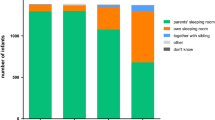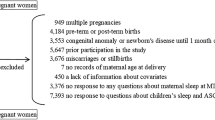Summary
Question of the Study
The study aimed at evaluating a possible association between low birth weight (LBW) and certain behavioural features during sleep in 2-month-old infants.
Patients and Methods
Eighty-three infants (35 boys, 48 girls) who were born in St. Petersburg in 2000 to 2002 and met a conventional definition of LBW (<2500 g at birth) entered the study. Of these, 66 (30 boys, 36 girls) were born both light and preterm (gestational age ≤36 weeks), and 17 (eight boys, nine girls) were born light but at term. The control group consisted of 112 infants (51 boys, 61 girls), made up of healthy babies born at term and having appropriate birth weight, matched to case babies for gender distribution, date of birth, calendar age at time of study, and geographical distribution within a city as close as possible. The mothers were asked to fill in the questionnaire addressing major infant, maternal and demographic characteristics, as well as the infant's major clinical signs and symptoms during daytime and at night. As a part of the interview, the mothers also completed a questionnaire addressing infant's behavioural features during sleep, which was based on Children's Sleep Habits Questionnaire.
Results
LBW infants presented with longer average total sleep duration (difference in the means equal to 1 h), principally due to longer night sleep. More often the parents rated LBW infants as sleeping too long and falling asleep in the transport; at bedtime, they were more often ready to fall asleep, but more frequently needed parents in the room and were put into parental bed beforehand. These associations remained significant after adjustments were made for major potential confounders. No statistically significant difference was found between the two groups in terms of the time the baby usually spent awake during the night, although LBW infants were more frequently brought to the parental bed, if awake. No statistically significant difference was found for any sleep characteristic between LBW infants who were born at term and those born preterm.
Conclusion
LBW and the factors leading to it should be considered cautiously as possible predictors of certain infant behavioural features and parental interventions during infant's sleep.
Zusammenfassung
Fragestellung
In dieser Studie geht es um die Prüfung einer möglichen Assoziation von niedrigem Geburtsgewicht mit bestimmten Verhaltensmerkmalen während des Schlafes zwei Monate alter Säuglinge.
Patienten und Methodik
Wir untersuchten 83 im Zeitraum 2000 bis 2002 in St. Petersburg geborene Säuglinge (35 Jungen, 48 Mädchen), die unter die konventionelle Definition eines niedrigen Geburtsgewichtes (LBW, low birth weight, <2500 g Geburtsgewicht) fielen. Von diesen waren 66 (30 Jungen, 36 Mädchen) leicht und frühgeboren (Gestationsalter ≤36 Wochen), und 17 (8 Jungen, 9 Mädchen) waren leicht, aber am Termin geboren. Sie wurden mit 112 gesunden, am Termin mit normalem Gewicht geborenen Säuglingen (51 Jungen, 61 Mädchen) nach Geschlecht, Geburtstag, Kalenderalter zum Zeitpunkt der Studie und möglichst naher geographischer Verteilung innerhalb der Stadt verglichen. Die Mütter wurden gebeten, einen Fragebogen das Kind betreffend auszufüllen, mütterliche und demographische Hauptcharakteristiken betreffend, wie auch die auffälligsten klinischen Anzeichen und Symptome während der Tages- und Nachtzeit. Zum Interview gehörte auch das Ausfüllen eines Fragebogens zu Verhalten smerkmalen des Kindes während des Schlafes auf der Basis des Fragebogens für kindliche Schlafgewohnheiten.
Ergebnisse
LBW-Kinder wiesen eine längere totale Schlafzeit auf (Mittelwerte), prinzipiell aufgrund längeren Nachtschlafes. Häufig gaben die Eltern von LBW-Kindern an, dass die Kinder zu lange schliefen und während des Transportes einschliefen. Zur zu Bettgehzeit waren sie eher bereit zu Schlafen, aber verlangten häufiger nach der Anwesenheit der Eltern und wurden erst einmal ins elterliche Bett gelegt. Diese Assoziationen blieben signifikant, nachdem die hauptsächlichen potentiellen Störgrößen im Modell aufgenommen wurden. Die Wachzeit während der Nacht unterschied sich nicht zwischen den Gruppen, allerdings wurden die LBW-Kinder häufiger ins elterliche Bett gelegt, wenn sie wach waren. Es wurden keine signifikanten Unterschiede zwischen LBW-Kindern, die zum Termin bzw. frühgeboren waren, gefunden.
Schlussfolgerung
LBW und die Faktoren, die dazu führen, sollten sorgfältig als mögliche Prädiktoren für bestimmte Verhaltensweisen der Säuglinge betrachtet werden und für elterliche Interventionen während des Schlafes des Säuglings.
Similar content being viewed by others
References
Armitage P, Berry G: Statistical methods in medical research. 3rd edition, Blackwell Science, Oxford, 1994.
Brandt P, Magyary D, Hammond M, Barnard K: Learning and behavioural-emotional problems of children bom preterm at second grade. J Pediatr Psychol 17: 291–311, 1992.
Coren S, Searleman A: Bitth stress and self-reported sleep difficulty. Sleep 8: 222–226, 1985.
Crowe TK, Deitz JC, Bennett FC, Tekolste K: Preschool motor skills of children bom prematurely and not diagnosed as having cerebral palsy. J Dev Behav Pediatr 9: 189–193, 1988.
Hack M, Taylor G, Klein N, Eiben R: Outcome of <750 gm birthweight children at school age. N Engl J Med 331: 753–759, 1994.
Heneghan AM, Silver EJ, Bauman LJ, Westbrook LE, Stein RE: Depressive symptoms in inner-city mothers of young children: who is at risk? Pediatrics 102: 1394–1400, 1998.
Hoffman HJ, Hillman LS: Epidemiology of the sudden infant death syndrome: matermal, neonatal, and postneonatal risk factors. Clin Perinatol 19: 717–738, 1992.
Ingersoll EW, Thoman EB: Sleep/wake states of preterm infants: stability, developmental change, diurnal variation, and relation with caregiving activity. Child Dev 70: 1–10, 1999.
Kahn A, Blum D, Rebuffat E, Sottiaux M, Levitt J, Bochner A, Alexaner M: Polysomnographic studies in infants who subsequently died of sudden infant death syndrome. Pediatrics 82: 721–727, 1988.
Kahn A, Groswasser J, Sottiaux M, Rebuffat E, Sunseri M, Franco P, Dramaix M: Clinical symptoms associated with brief obstructive sleep apnea in normal infants. Sleep 16: 409–413, 1993.
Kelmanson IA: An assessment of the microsocial environment of children diagnosed as ‘sudden infant death’ using the ‘PRCESS’ inventory. Eur J Pediatr 152: 686–690, 1993.
Kelmanson IA: Low birth weight and behavioural features in infants under one year old. Early Child Dev Care 135: 61–70, 1999.
Klein NK: Children who were very low birthweight: Cognitive abilities and classroom behavior at five years of age. J Spec Educ 22: 41–54, 1988.
McCormic MC, Gortmaker SL, Sobol AM: Very low birth weight children: Behavioral problems and school difficulty in a national sample. J Pediatr 117: 687–693, 1990.
McDermott S, Cokert AL, McKeown RE: Low birth weight and risk of mild mental retardation by ages 5 and 9 to 11. Paed Perinat Epidemiol 7: 195–204, 1993.
Medoff-Cooper B: Temperatment in very low birth infants. Nurs Res 35: 139–143, 1986.
Mitchell EA, Taylor BJ, Ford RPK, Steward AW, Becroft DMO, Thompson JMD et al.: Four modifiable and other major risk factors for cot death: The New Zealand study. J Pediatr Child Health 28 (Suppl. 1): 3–8, 1992.
Oberklaid F, Prior M, Sanson A: Temperament of preterm versus full-term infants. J Dev Behav Pediatr 7: 159–162, 1986.
Oehler JM, Thompson RJ, Goldstein RF, Gustafson KE, Brazy JE: Behavioral characteristics of very-low-birth-weight infants of varying biologic risk at 6, 15, and 24 months of age. J Obstet Gynecol Neonatal Nurs 25: 233–239, 1996.
Owens JA, Spirito A, McGuinn M: The Children's Sleep habits Questionnaire (CSHQ): psychometric properties of a survey instrument for school-aged children. Sleep 23: 1043–1051, 2000.
Ross, G, Lipper EG, Auld PAM: Social competence and behavior problems in premature children at school age. Pediatrics 86: 391–397, 1990.
Sondergaard C, Skajaa E, Henriksen TB: Fetal growth and infatile colic. Arch Dis Child Fetal Neonatal Ed 83: F44-F47, 2000.
Thatch BT, Davies AM, Koenig JS: Pathophysiology of sudden upper airway obstruction in sleeping infants and its relevance for SIDS. Ann NY Acad Sci 533: 314–328, 1988.
Ungerer JA, Sigman M, Beckwith L, Cohen SE, Parmelee AH: Sleep behavior of preterm children at three years of age. Dev Med Child Neurol 25: 297–304, 1983.
Walker J: The behaviour of 3-year-old children who were born preterm. Child Care Halth Dev 15: 297–313, 1989.
Watt JE, Strongman KT: The organization and stability of sleep states in in fullterm, preterm, and small-for-gestational-age infants: a comparative study. Dev Psychobiol 18: 151–162, 1985.
Wolke D, Meyer R, Ohrt B, Riegel K: The incidence of sleeping problems in preterm and fullterm infants discharged from neonatal special care units: an epidemiological longitudinal study. J Child Psychol Psychiatry 36: 203–223, 1995.
Yokochi K, Shiroiwa Y, Inukai K, Kito H, Ogawa J: Behavioral state distribution throughout 24-h video recordings in preterm infants at term with good prognosis. Early Hum Dev 19: 183–190, 1989.
Author information
Authors and Affiliations
Corresponding author
Rights and permissions
About this article
Cite this article
Kelmanson, I.A., Adulas, E.I. Low birth weight and sleep behaviour in two-month-old infants. Somnologie 6, 155–160 (2002). https://doi.org/10.1046/j.1439-054X.2002.02191.x
Issue Date:
DOI: https://doi.org/10.1046/j.1439-054X.2002.02191.x




